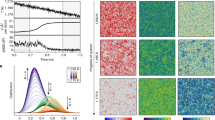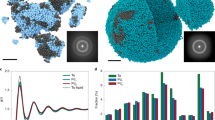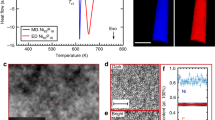Abstract
Amorphous silicon is a semiconductor with a lower density than the metallic silicon liquid. It is widely believed that the amorphous–liquid transition is a first-order melting transition. In contrast to this, recent computer simulations and the experimental observation of pressure-induced amorphization of nanoporous silicon have revived the idea of an underlying liquid–liquid phase transition implying the existence of a low-density liquid and its glass transition to the amorphous solid. Here we demonstrate that during irradiation with high-energy heavy ions amorphous silicon deforms plastically in the same way as conventional glasses. This behaviour provides experimental evidence for the existence of the low-density liquid. The glass transition temperature for a timescale of 10 picoseconds is estimated to be about 1,000 K. Our results support the idea of liquid polymorphism as a general phenomenon in tetrahedral networks.
This is a preview of subscription content, access via your institution
Access options
Subscribe to this journal
Receive 12 print issues and online access
$259.00 per year
only $21.58 per issue
Buy this article
- Purchase on Springer Link
- Instant access to full article PDF
Prices may be subject to local taxes which are calculated during checkout





Similar content being viewed by others
References
Liu, P. L., Yen, R., Bloembergen, N. & Hodgson, R. T. Picosecond laser-induced melting and resolidification morphology on Si. Appl. Phys. Lett. 34, 864–866 (1979).
Matsumura, H. & Tachibana, H. Amorphous silicon produced by a new thermal chemical vapor deposition method using intermediate species SiF2 . Appl. Phys. Lett. 47, 833–835 (1985).
Deb, S. K., Wilding, M., Somayazulu, M. & McMillan, P. F. Pressure-induced amorphization and an amorphous–amorphous transition in densified porous silicon. Nature 414, 528–530 (2001).
Glaser, E., Götz, G., Sobolev, N. & Wesch, W. Investigations of radiation damage production in ion implanted silicon. Phys. Status Solidi A 69, 603–614 (1982).
Jakse, N. et al. Structural changes on supercooling liquid silicon. Appl. Phys. Lett. 83, 4734–4736 (2003).
Baeri, P., Campisano, S. U., Grimaldi, M. G. & Rimini, E. Experimental investigation of the amorphous silicon melting temperature by fast heating processes. J. Appl. Phys. 53, 8730–8733 (1982).
Donovan, E. P., Spaepen, F., Turnbull, D., Poate, J. M. & Jacobson, D. C. Heat of crystallization and melting-point of amorphous-silicon. Appl. Phys. Lett. 42, 698–700 (1983).
Thompson, M. O. et al. Melting temperature and explosive crystallization of amorphous silicon during pulsed laser irradiation. Phys. Rev. Lett. 52, 2360–2363 (1984).
Donovan, E. P., Spaepen, F., Poate, J. M. & Jacobson, D. C., Homogeneous and interfacial heat releases in amorphous silicon, Appl. Phys. Lett. 55, 1516–1518 (1989).
Properties of Amorphous Silicon and its Alloys, EMIS Datareview Series no. 19 (ed. Searle, T.) ch. 8.8 (Short Run Press, Exeter, 1998).
McMillan, P. F. Polyamorphic transformations in liquids and glasses. J. Mater. Chem. 14, 1506–1512 (2004).
Aptekar, L. I. Phase transitions in noncrystalline germanium and silicon. Sov. Phys. Dokl. 24, 993–995 (1979).
Sastry, S. & Angell, C. A. Liquid-liquid phase transition in supercooled silicon. Nature Mater. 2, 739–743 (2003).
Funamori, N. & Tsuji, K. Pressure-induced structural change of liquid silicon. Phys. Rev. Lett. 88, 255508–1–255508–4 (2002).
Morishita, T. High density amorphous form and polyamorphic transformations of silicon. Phys. Rev. Lett. 93, 055503-1–055503-4 (2004).
Keblinski, P., Bazant, M. Z., Dash, R. K. & Treacy, M. M. Thermodynamic behavior of a model covalent material described by the environment-dependent interatomic potential. Phys. Rev. B 66, 064104 (2002).
Miranda, C. R. & Antonelli, A. Transitions between disordered phases in supercooled liquid silicon. J. Chem. Phys. 120, 11672–11677 (2004).
Roorda, S., Doorn, S., Sinke, W. C., Scholte, P. M. L. O. & van Loenen, E. Calorimetric evidence for structural relaxation in amorphous silicon. Phys. Rev. Lett. 62, 1880–1883 (1989).
Roorda, S. et al. Structural relaxation and defect annihilation in pure amorphous silicon. Phys. Rev. B 44, 3702–3725 (1991).
Klaumünzer, S. & Schumacher, G. Dramatic growth of glassy Pd80Si20 during heavy-ion irradiation. Phys. Rev. Lett. 51, 1987–1990 (1983).
Klaumünzer, S., Hou, M.-D. & Schumacher, G. Coulomb explosion in a metallic glass due to the passage of fast heavy ions? Phys. Rev. Lett. 57, 850–853 (1986).
Klaumünzer, S. Plastic flow of amorphous materials induced by swift heavy ions. Mater. Sci. For. 97–99, 623–630 (1992).
Klaumünzer, S. in Multiscale Phenomena in Plasticity: From Experiments to Phenomenology, Modelling and Materials Engineering (eds Lepinoux, J., Maziere, D., Pontikis, V. & Saada, G.) 441–450 (NATO Science Series Vol. 367, 2000).
Hou, M. D., Klaumü nzer, S. & Schumacher, G. Dimensional changes of metallic glasses during bombardment with fast heavy ions. Phys. Rev. B 41, 1144–1157 (1990).
Gutzmann, A. & Klaumünzer, S. Shape instability of amorphous materials during high-energy ion bombardment. Nucl. Instrum. Meth. B 127/128, 12–17 (1997).
Chicoine, M., Roorda, S., Cliche, L. & Masut, R. A. Directional effects during ion implantation: lateral mass transport and anisotropic growth. Phys. Rev. B 56, 1551–1560 (1997).
van Dillen, T. et al. Ion beam-induced anisotropic plastic deformation of silicon microstructures. Appl. Phys. Lett. 84, 3591–3593 (2004).
Audouard, A. et al. High-energy ion irradiations of Fe85B15 amorphous alloy: evidence for electronic energy loss effect. Europhys. Lett. 3, 327–331 (1987).
Audouard, A. Balanzat, E., Jousset, J. C., Lesueur, D. & Thomé, L. Atomic displacements and atomic motion induced by electronic excitation in heavy-ion-irradiated amorphous metallic alloy. J. Phys. Condens. Mater. 5, 995–1018 (1993).
Sundaram, S. K. & Mazur, E. Inducing and probing non-thermal transitions in semiconductors using femtosecond laser pulses. Nature Mater. 1, 217–224 (2002).
Cavalleri, A. et al. Femtosecond melting and ablation of semiconductors studied with time of flight mass spectroscopy. J. Appl. Phys. 85, 3301–3309 (1999).
Silvestrelli, P. L., Alavi, A., Parrinello, M. & Frenkel, D. Structural, dynamical, electronic, and bonding properties of laser-heated silicon: An ab initio molecular-dynamics study. Phys. Rev. B 56, 3806–3812 (1997).
Landolt-Börnstein — Group III Condensed Mattter New Series Vol. 41E/17i (eds Madelung, O., Schulz, M. & Weiss, H.) 40–41 (Springer, Berlin, 2003).
Sato, Y. et al. Viscosity of molten silicon and the factors affecting measurement. J. Cryst. Growth 249, 404–415 (2003).
Hosokawa, S. et al. Sub-picosecond dynamics in liquid Si. J. Phys. Condens. Matter 15, L623–L629 (2003).
Trinkaus, H. & Ryazanov, A. I. Viscoelastic model for the plastic flow of amorphous solids under energetic ion bombardment. Phys. Rev. Lett. 74, 5072–5075 (1995).
Trinkaus, H. Local stress relaxation in thermal spikes as a possible cause for creep and macroscopic stress relaxation of amorphous solids under irradiation. J. Nucl. Mater. 223, 196–201 (1995).
Trinkaus, H. Dynamics of viscoelastic flow in ion tracks: origin of plastic deformation of amorphous materials. Nucl. Instrum. Meth. B 146, 204–216 (1998).
Trinkaus, H. Thermal spike model for irradiation creep of amorphous solids: comparison to experimental data for ion irradiated vitreous silica. J. Nucl. Mater. 246, 244–246 (1997).
Keblinski, P., Wolf, D., Phillpot, S. R. & Gleiter, H. Continuous thermodynamic-equilibrium glass transition in high-energy grain boundaries? Phil. Mag. Lett. 76, 143–151 (1997).
Aasland, S. & McMillan, P. F. Density-driven liquid–liquid phase separation in the system Al2O3–Y2O3 . Nature 369, 633–636 (1994).
Ziegler, J. F., Biersack, J. P. & Littmark, U. in The Stopping and Range of Ions in Solids (Pergamon, New York, 2003).
Eshelby, J. D. The determination of the elastic field of an ellipsoidal inclusion, and related problems. Proc. R. Soc. Lond. A 241, 376–396 (1957).
Mura, T. Micromechanics of Defects in Solids 2nd edn (Martinus Nijhoff, 1987).
Acknowledgements
We thank H. Trinkaus, E. Wendler and A. Kamarou for discussions and U. Kaiser, H. Hobert and C. Voigt for their contributions to the analysis of the samples.
Author information
Authors and Affiliations
Corresponding author
Ethics declarations
Competing interests
The authors declare no competing financial interests.
Supplementary information
Rights and permissions
About this article
Cite this article
Hedler, A., Klaumünzer, S. & Wesch, W. Amorphous silicon exhibits a glass transition. Nature Mater 3, 804–809 (2004). https://doi.org/10.1038/nmat1241
Received:
Accepted:
Published:
Issue Date:
DOI: https://doi.org/10.1038/nmat1241
This article is cited by
-
Origins of structural and electronic transitions in disordered silicon
Nature (2021)
-
Tension–compression asymmetry in amorphous silicon
Nature Materials (2021)
-
Uncovering the effects of interface-induced ordering of liquid on crystal growth using machine learning
Nature Communications (2020)



